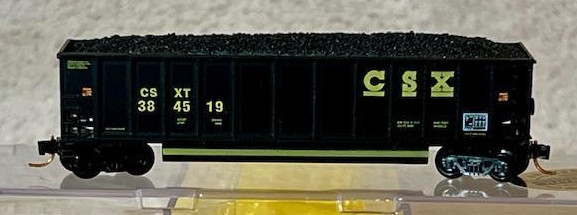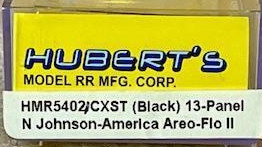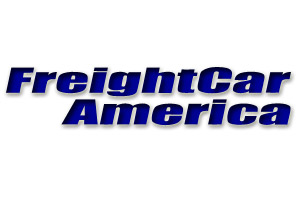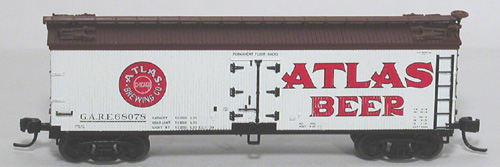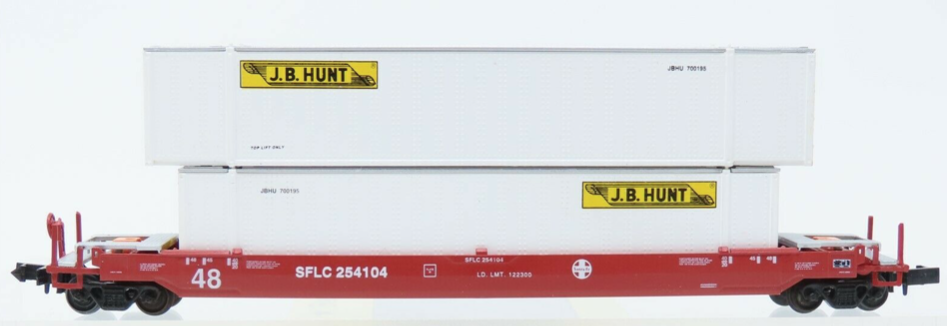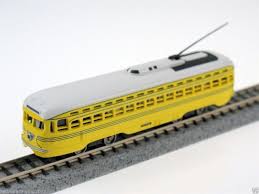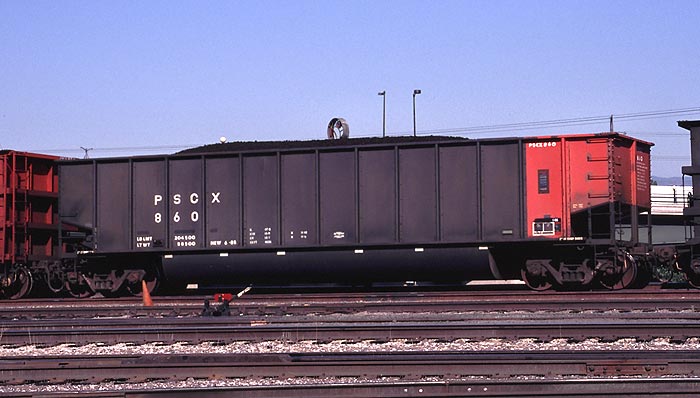Model Information: These models come with optional, user-installed weights and internal bracing.
Prototype History: The Powder River Basin is a hot bed of coal activity. There is more coal run out of this one area than all other areas of the US combined. It is an amazing railfan opportunity, as there is train after train after train of 100+ cars leaving the basin for power plants all over the country. The trains pull through a mine and are flow loaded, with the train continuously moving at very slow speed, while the loader operator drops up to 110 tons of coal into each aluminum car. It is an awesome site to see. The flow loader piles the coal into the car, and each load settles to it's own shape. At the other end of the chain, many of the power plants or shipping docks (yes, some of this high quality cleaner burning coal goes overseas, too) unload the cars by rolling them over, while they are still coupled in the train. This is accomplished by use of a rotary coupler, which needs to be oriented correctly in the train in order to work. The orientation is accomplished visually by the unique colored end, or rotary end on the car. You will find these trains anywhere along their route with all of the rotaries lined up in the same direction. Each car is equipped with one rotary coupler, and one fixed coupler (the exceptions are the double rotary cars, which we'll get to in a second), so that the car can be rolled over without uncoupling. The most recent version of the car is constructed of aluminum for weight and strength reasons. The side stakes are a box shape of aluminum, and have distinctive crisp square corners. The earlier version of the car was made in steel, with folded steel "hat section" stiles that were thinner and rounder. Johnstown America is a pioneer in getting the most out of their materials.
When they introduced the revolutionary original all steel construction Bethgon, they started a change in the way railroads thought about coal transportation. With the Coalporter, the revolution continued. Now they are working on even more advanced systems to deliver clean fuel to America's electric plants. With their innovations, the Twin Tub has become one of the dominant coal conveyances in modern railroading. Certainly it is distinctive seeing 105 car unit trains on the rails. The cars on the road today are divided into several types. The railroad trains, like BNSF, and Norfolk Southern, are contract trains. They transport on routes that they have bid for and service with a rotating pool of equipment. The power company trains are owned or leased specifically by a particular power company, and run on a dedicated route from the coal mine to the power plant and back. From time to time, the power plant will require more coal than their owned equipment is capable of carrying, and they will lease or hire additional cars. These may come from a leasing organization (Transisco, Systems Fuels, or First Union), a railroad, or another power plant that may have over capacity. Portland General Electric is a good example of leasable trains. The Portland Rose cars often sit idle when local hydro electric power plants are generating at full capacity. At these times, the cars get leased out to other power companies at favorable rates. It is not unusual to see a train full of Portland Rose cars on it's way to San Antonio or St Louis when the Pacific Northwest has full rivers! The double rotary cars ride next to the locomotives or at any position where the train may need to be pulled in both directions to unload. If the unloader is placed on a stub track, at the end of the line, or on a wye, the loco may be tied onto either end, making it impossible to predict which way to order the cars (rotary first or non-rotary first). In these instances a double rotary is used. They are very distinctive, as whatever color is used to indicate a rotary coupler is visible on both ends. In the case of the PGEX cars, each end is equipped with colored panels and the four color rose.
When they introduced the revolutionary original all steel construction Bethgon, they started a change in the way railroads thought about coal transportation. With the Coalporter, the revolution continued. Now they are working on even more advanced systems to deliver clean fuel to America's electric plants. With their innovations, the Twin Tub has become one of the dominant coal conveyances in modern railroading. Certainly it is distinctive seeing 105 car unit trains on the rails. The cars on the road today are divided into several types. The railroad trains, like BNSF, and Norfolk Southern, are contract trains. They transport on routes that they have bid for and service with a rotating pool of equipment. The power company trains are owned or leased specifically by a particular power company, and run on a dedicated route from the coal mine to the power plant and back. From time to time, the power plant will require more coal than their owned equipment is capable of carrying, and they will lease or hire additional cars. These may come from a leasing organization (Transisco, Systems Fuels, or First Union), a railroad, or another power plant that may have over capacity. Portland General Electric is a good example of leasable trains. The Portland Rose cars often sit idle when local hydro electric power plants are generating at full capacity. At these times, the cars get leased out to other power companies at favorable rates. It is not unusual to see a train full of Portland Rose cars on it's way to San Antonio or St Louis when the Pacific Northwest has full rivers! The double rotary cars ride next to the locomotives or at any position where the train may need to be pulled in both directions to unload. If the unloader is placed on a stub track, at the end of the line, or on a wye, the loco may be tied onto either end, making it impossible to predict which way to order the cars (rotary first or non-rotary first). In these instances a double rotary is used. They are very distinctive, as whatever color is used to indicate a rotary coupler is visible on both ends. In the case of the PGEX cars, each end is equipped with colored panels and the four color rose.
Road Name History: CSX Transportation (reporting mark CSXT) is a Class I railroad in the United States. The main subsidiary of the CSX Corporation, the railroad is headquartered in Jacksonville, Florida, and owns about 21,000 route miles (34,000 km). CSX operates one of the three Class I railroads serving most of the East Coast, the other two being the Norfolk Southern Railway (NS) and Canadian Pacific Railway. It also serves the Canadian provinces of Ontario and Quebec. Together CSX and Norfolk Southern Railway have a duopoly over all east-west freight rail traffic east of the Mississippi River. As of October 1, 2014 CSX's total public stock value was slightly over $32 billion.
CSX Transportation was formed on November 1, 1980, by combining the railroads of the former Chessie System with Seaboard Coast Line Industries, and finally with the Seaboard System Railroad in 1986. The originator of the Seaboard System was the former Seaboard Air Line Railroad, which previously merged with the Atlantic Coast Line Railroad in 1967, and later with the Louisville & Nashville Railroad, as well as several smaller subsidiaries such as the Clinchfield Railroad, Atlanta & West Point Railroad, Monon Railroad and the Georgia Railroad. The origin of the Chessie System was the former Chesapeake & Ohio Railway, which had merged with the Baltimore & Ohio Railroad, and the Western Maryland Railway.
Read more on Wikipedia.
CSX Transportation was formed on November 1, 1980, by combining the railroads of the former Chessie System with Seaboard Coast Line Industries, and finally with the Seaboard System Railroad in 1986. The originator of the Seaboard System was the former Seaboard Air Line Railroad, which previously merged with the Atlantic Coast Line Railroad in 1967, and later with the Louisville & Nashville Railroad, as well as several smaller subsidiaries such as the Clinchfield Railroad, Atlanta & West Point Railroad, Monon Railroad and the Georgia Railroad. The origin of the Chessie System was the former Chesapeake & Ohio Railway, which had merged with the Baltimore & Ohio Railroad, and the Western Maryland Railway.
Read more on Wikipedia.
Brand/Importer Information:  Hubert's Model Railroad Mfg Corp group was located in Roseburg, Oregon and then Cincinnati, Ohio. Frank Hubert purchased the toolings of the LBF company (a.k.a. USA Plastics), that itself succeeded to E&C Shops, both founded by Fred Becker. Hubert had been one of Becker's partners in LBF/USA Plastics. Later, when Hubert's operation folded by the end of 2007, the toolings were acquired by InterMountain.
Hubert's Model Railroad Mfg Corp group was located in Roseburg, Oregon and then Cincinnati, Ohio. Frank Hubert purchased the toolings of the LBF company (a.k.a. USA Plastics), that itself succeeded to E&C Shops, both founded by Fred Becker. Hubert had been one of Becker's partners in LBF/USA Plastics. Later, when Hubert's operation folded by the end of 2007, the toolings were acquired by InterMountain.
Like its predecessors, Hubert's released every road name with 12 to 48 different road numbers, offering the cars in 6- or 12-packs.

Like its predecessors, Hubert's released every road name with 12 to 48 different road numbers, offering the cars in 6- or 12-packs.
Item created by: George on 2024-01-25 09:11:56. Last edited by George on 2024-01-25 09:14:13
If you see errors or missing data in this entry, please feel free to log in and edit it. Anyone with a Gmail account can log in instantly.
If you see errors or missing data in this entry, please feel free to log in and edit it. Anyone with a Gmail account can log in instantly.


